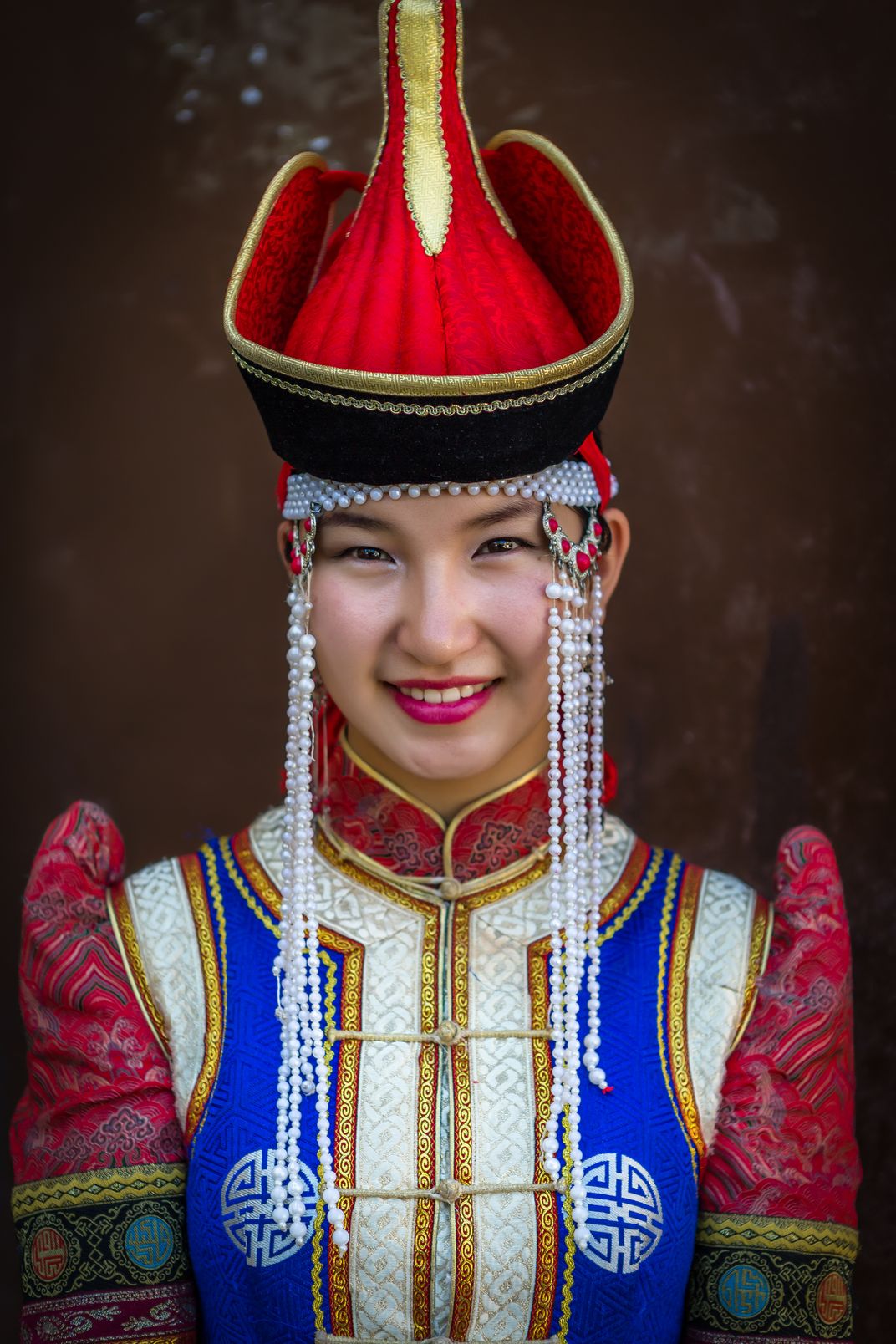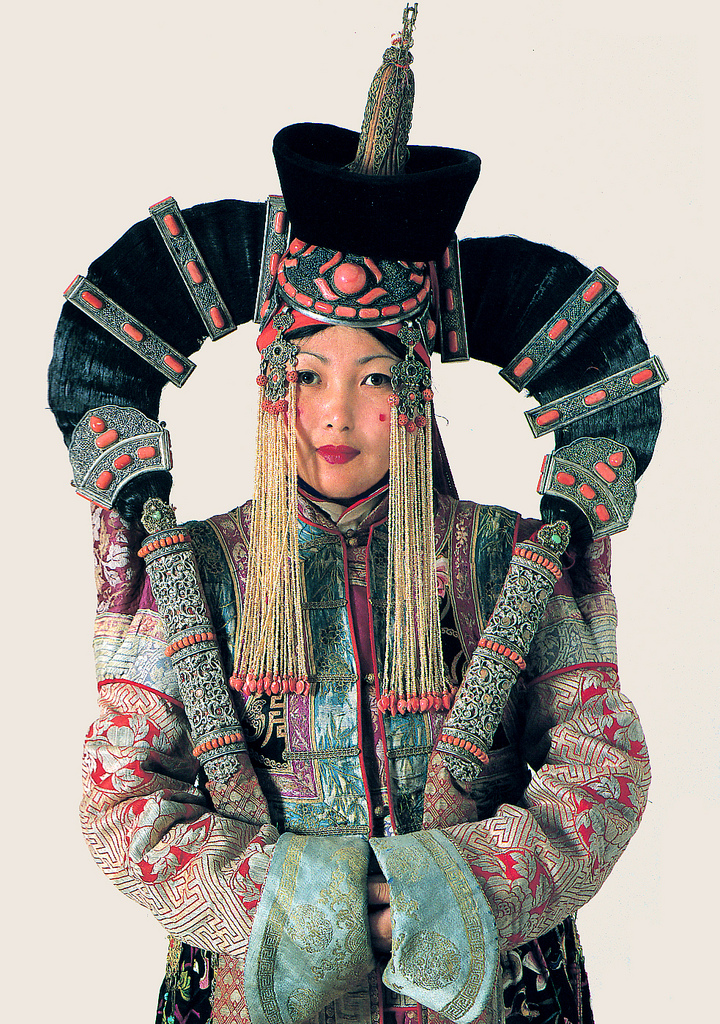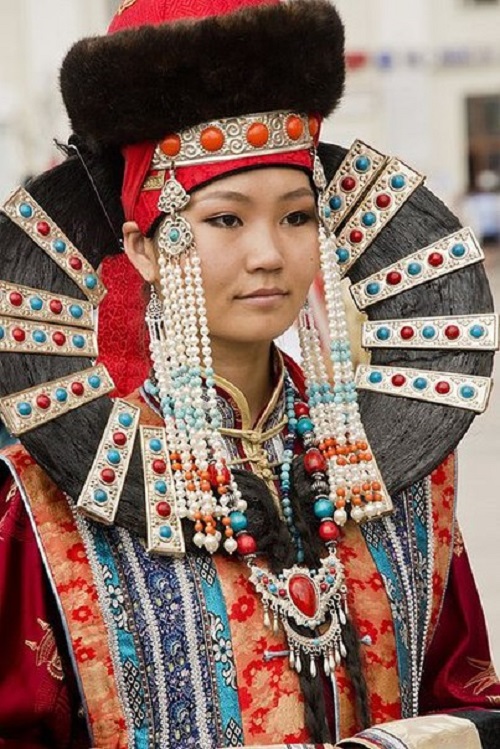
Mongolian Deel Attire Smithsonian Photo Contest Smithsonian Magazine
Traditional Mongolian Clothing. Gear up for a journey to Mongolia with a twist - dive into the world of Mongolian traditional clothes! Picture this: relieving the vibes of Mongolian nomads that have rocked the steppes for ages. Oh, and did I mention the extreme weather hacks woven right into the deel's design? Get to know more below!

turn of the century color photos mongolia Google Search Costumes around the world, Mongolia
The deel, or kaftan, is the Mongolian traditional garment worn on workdays and special days. It is a long, loose gown cut in one piece with the sleeves; it has a high collar and widely overlaps at the front. The deel is girdled with a sash. Mongolian deels always close on the wearer's right and traditionally have five fastenings.

Traditional outfits, Mongolian clothing, Carnival outfits
The Mongolian traditional costume consists of a deel, a hat, boots, and accessories. There are differences between the costumes of the various ethnic groups, but all the deels have the same shape: long sleeves, a wide flap that gets folded up on the chest, buttons on the right shoulder, a high collar, and a fabric belt around the waist.

Mongolian Traditional Dress Cultures and Clothes Traditional dresses, Traditional outfits
The first form of Mongolian deel can be found during the Hun era, a long tunic made with leather or animal skin. Around that time, in the 6th to 13th century, the Turkic had a similar gown as deel which was worn in the opposite direction. That's why some countries in central Asia have traditional clothing similar to deel.

Mongolian woman in traditional clothes Traditional outfits, Fashion, Traditional dresses
Typical items included felt hats, long jackets with loose sleeves, and practical baggy trousers. As the Mongol army was based on fast-moving, lightly armed cavalry, recruiters usually had a relaxed 'come-as-you-are' approach to uniforms so that clothes in both war and peace were often very similar.

Deeltei Mongol Naadam Mongolian National Costume Festival
Even in the pastoral areas, people wear traditional clothes and modern clothes alternately. Only during festivals, weddings, or at the Nadam Fair do people wear colorful traditional clothes. The colorful Mongolian traditional costumes reflect the wisdom and aesthetic taste of the people, and symbolize their frankness and open-mindedness, which has become a typical symbol of the Mongolian culture.

mongolian junior fashion Google Search Folk clothing, Traditional outfits, Historical clothing
A deel ( Mongolian: ᠳᠡᠪᠡᠯ /дээл [deːɮ]; Buryat: дэгэл [dɛɡɛɮ]) is an item of traditional clothing commonly worn by Mongols and Turkic and Tungusic peoples for centuries, [1] and can be made from cotton, silk, wool, or brocade . The deel is still commonly worn by both men and women outside major towns, especially by herders. [2]

Local style Traditional headdresses of the Mongolian women
Mongolian clothes include hat, deel, uuj, coat, vest, underclothes and boots. The main material of the deel clothes is silk. There is similarity of style and meaning while the clothes are showing their own ethnicities. However different men's clothes, they are pretty same to each other in any territories.

Mongol Woman in Traditional Outfit. Xiangshawan. Inner Mongolia, China Pentax User Photo Gallery
Their traditional clothes are called a deel. It's pronounced "dell" like the-farmer-in-the, but it doesn't mean a clearing. The deel is a really practical bit of clothing. It's almost like a tunic - there are arm holes and it buttons up cozily. It's worn by both genders and comes in many different colors.

MONGOLIAN GIRL Mongolian girl, Nomad clothing, Traditional fashion
THE MONGOLIAN TRADITIONAL COSTUME CONSISTS OF HAT, DEEL, BOOTS AND ACCESSORIES. Hats One of the most colorful and original items of Mongolian national dress is the traditional headwear.

Local style Traditional headdresses of the Mongolian women
The most common type of Mongolian traditional clothing is the deel, which is a long robe that is worn over other clothing. Table of Contents HATS BELTS Mongolian Boots BUY NEW DEEL Mongolian traditional costume Deels are typically made from wool or cotton, and they can be decorated with a variety of colorful patterns.

Traditional Mongolian costumes Traditional outfits, National clothes, East fashion
"Mongolian Traditional Clothing: Unveiling Centuries of Style and Significance" Posted on September 7, 2023 by Mongolianz 07 Sep Mongolian traditional clothing and fashion aren't just fabrics; they're an embroidered tale of history and heritage, woven with threads of cultural significance.

Mongolian Fashion
Traditional clothing is the representation and evaluability of the unique culture and traditions of ethnic groups. Clothing varies depending on the status, age and gender in each culture. Mongolian hat In Mongolia, a hat is the most important piece of clothing, representing the status of the wearer.

Pin on
CLOTHING SKIN CARE ARCHERY SOUVENIR Our most popular products Camping Yurt/GER/ Rated 4.25 out of 5 $ 2,250.00 - $ 4,550.00 Mongolian Warrior Sculpture Rated 4.83 out of 5 $ 140.00 Beginner Light Brown Morin Khuur with Grip Rated 4.86 out of 5 $ 470.00 Sheep Wool Sleeping Bag Rated 5.00 out of 5 $ 240.00 - $ 310.00 Boots With White Embroidery

Ethnic Mongolian jewellery Kaleidoscope effect
The material used for clothing was wool, cotton, silk and hemp. Black, red, white, and brown were the main colors for clothing design. Mongolia clothing history can be considered as one of the oldest in the world. Even the 12th century witnessed a significant change in clothing design.

The Most Famous 5 Mongolian Women, Facts, History (2023)
The Deel: A Nomadic Staple At the heart of Mongolian festive attire lies the iconic "Deel", a traditional robe worn with grace by both men, women and even kids. Beyond its loose, flowing design that provides comfort in the ever-changing Mongolian climate, the Deel symbolizes the nomadic spirit of adaptability and freedom.